

Scholasticism. Science in the Middle Ages. Medieval medicine of Western Europe. Medieval medicine in Western Europe was composed of a mixture of existing ideas from antiquity, spiritual influences and what Claude Lévi-Strauss identifies as the "shamanistic complex" and "social consensus.
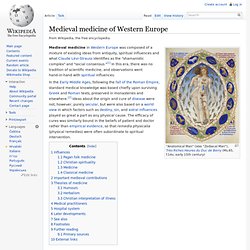
"[1] In this era, there was no tradition of scientific medicine, and observations went hand-in-hand with spiritual influences. In the Early Middle Ages, following the fall of the Roman Empire, standard medical knowledge was based chiefly upon surviving Greek and Roman texts, preserved in monasteries and elsewhere.[2] Ideas about the origin and cure of disease were not, however, purely secular, but were also based on a world view in which factors such as destiny, sin, and astral influences played as great a part as any physical cause.
The efficacy of cures was similarly bound in the beliefs of patient and doctor rather than empirical evidence, so that remedia physicalia (physical remedies) were often subordinate to spiritual intervention. Influences[edit] Pagan folk medicine[edit] Ethnocentrism. Ethnocentrism is judging another culture solely by the values and standards of one's own culture.[1][page needed] Ethnocentric individuals judge other groups relative to their own ethnic group or culture, especially with concern for language, behavior, customs, and religion.
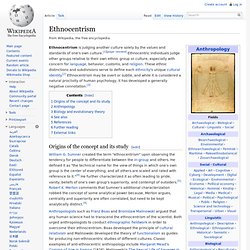
These ethnic distinctions and subdivisions serve to define each ethnicity's unique cultural identity.[2] Ethnocentrism may be overt or subtle, and while it is considered a natural proclivity of human psychology, it has developed a generally negative connotation.[3] Origins of the concept and its study[edit] William G. Sumner created the term "ethnocentrism" upon observing the tendency for people to differentiate between the in-group and others.
He defined it as "the technical name for the view of things in which one's own group is the center of everything, and all others are scaled and rated with reference to it Anthropology[edit] Biology and evolutionary theory[edit] See also[edit] References[edit] Jump up ^ John T. Gothic architecture. The interior of the western end of Reims Cathedral Gothic architecture is a style of architecture that flourished during the high and late medieval period.
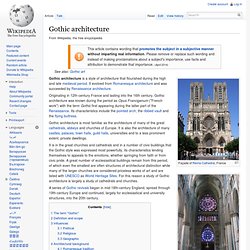
It evolved from Romanesque architecture and was succeeded by Renaissance architecture. Medieval art. Byzantine monumental Church mosaics are one of the great achievements of medieval art.
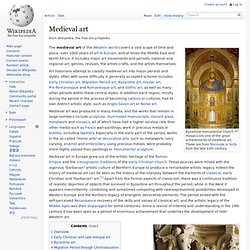
These are from Monreale in Sicily from the late 12th century. The medieval art of the Western world covers a vast scope of time and place, over 1000 years of art in Europe, and at times the Middle East and North Africa. It includes major art movements and periods, national and regional art, genres, revivals, the artists crafts, and the artists themselves. Art historians attempt to classify medieval art into major periods and styles, often with some difficulty. A generally accepted scheme includes Early Christian art, Migration Period art, Byzantine art, Insular art, Pre-Romanesque and Romanesque art, and Gothic art, as well as many other periods within these central styles. Medieval music. Medieval music is Western music written during the Middle Ages.
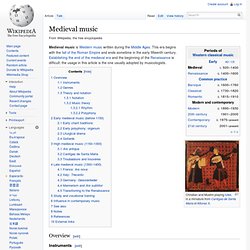
This era begins with the fall of the Roman Empire and ends sometime in the early fifteenth century. Establishing the end of the medieval era and the beginning of the Renaissance is difficult; the usage in this article is the one usually adopted by musicologists. Overview[edit] Instruments[edit] Medieval theatre. Early Medieval period[edit] Hrosvitha of Gandersheim, the first dramatist of the post-classical era.
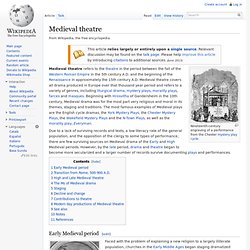
Faced with the problem of explaining a new religion to a largely illiterate population, churches in the Early Middle Ages began staging dramatized versions of particular biblical events on specific days of the year. These dramatizations were included in order to vivify annual celebrations.[1] Symbolic objects and actions (vestments, altars, censers, and pantomime performed by priests) recalled the events which Christian ritual celebrates. These were extensive sets of visual signs that could be used to communicate with a largely illiterate audience. These performances developed into liturgical dramas, the earliest of which is the Whom do you Seek (Quem-Quaeritis) Easter trope, dating from ca. 925.[2] Liturgical drama was sung responsively by two groups and did not involve actors impersonating characters.
Transition from Rome, 500-900 A.D. Medieval literature. Medieval literature is a broad subject, encompassing essentially all written works available in Europe and beyond during the Middle Ages (encompassing the one thousand years from the fall of the Western Roman Empire ca.
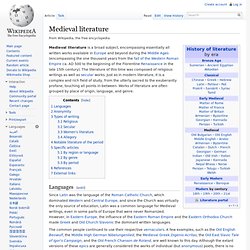
AD 500 to the beginning of the Florentine Renaissance in the late 15th century). The literature of this time was composed of religious writings as well as secular works. Just as in modern literature, it is a complex and rich field of study, from the utterly sacred to the exuberantly profane, touching all points in-between. Crisis of the Late Middle Ages. The Crisis of the Late Middle Ages refers to a series of events in the fourteenth and fifteenth centuries that brought centuries of European prosperity and growth to a halt.[1] Three major crises led to radical changes in all areas of society - they were demographic collapse, political instabilities and religious upheavals.
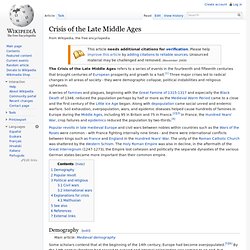
A series of famines and plagues, beginning with the Great Famine of 1315-1317 and especially the Black Death of 1348, reduced the population perhaps by half or more as the Medieval Warm Period came to a close and the first century of the Little Ice Age began. Along with depopulation came social unrest and endemic warfare. Soil exhaustion, overpopulation, wars, and epidemic diseases helped cause hundreds of famines in Europe during the Middle Ages, including 95 in Britain and 75 in France.[2][3] In France, the Hundred Years' War, crop failures and epidemics reduced the population by two-thirds.[4] Christian monasticism. 'St.

Paul the Hermit Fed by the Raven', after Il Guercino, Dayton Art Institute Christian monasticism is the devotional practice of individuals who live ascetic and typically cloistered lives that are dedicated to Christian worship. Gnosticism. High Middle Ages.